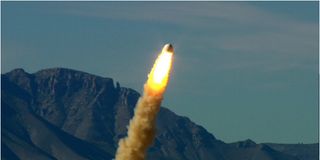Why Is Jeff Bezos Going to Crash His Rocket?

Before test pilots or paying passengers fly aboard Blue Origin's New Shepard suborbital spaceship, the company, owned by Amazon founder Jeff Bezos, wants to make sure they can survive a botched launch.
Toward that end, the company is preparing for a key test of the capsule's emergency escape system. The so-called in-flight abort test, scheduled for Tuesday, will be dramatic, no matter how it ends, Bezos wrote on the Blue Origin website.
The test begins with ignition of the New Shepard rocket, which will be flying for the fifth time. About 45 seconds after liftoff, a computer command will trigger an intentional capsule escape at an altitude of about 16,000 feet, said Blue Origin president Rob Meyerson.
RELATED: Inside Jeff Bezos' Secret Blue Origin Rocket Factory
A redundant separation system will sever the capsule from the booster. At the same time, the capsule's solid fuel motor will ignite for two seconds to steer the capsule to the side and out of the booster's path.
The capsule will then coast, stabilizing itself by firing small thrusters, as it descends back into the atmosphere. If all goes as planned, the capsule will then deploy its three drogue chutes, followed by three main parachutes for a gentle touchdown near Blue Origin's West Texas launch site.
The booster rocket is not expected to fare as well.
Get the Space.com Newsletter
Breaking space news, the latest updates on rocket launches, skywatching events and more!
The capsule's escape motor will slam the booster with 70,000 pounds of thrust, Meyerson said.
WATCH VIDEO: What Will Future Rockets Look Like?
"It's going to be delivered by blistering hot exhaust, and the force from that blast is going to try to both decelerate the booster and tip it over," Meyerson said during a presentation at the International Astronautical Congress in Guadalajara, Mexico, last week.
"If it tips too much, our thrust termination system will actually cut out thrust to the engine. In that case, the booster will fall into the West Texas desert and create a spectacular sight.
"If the booster manages to right itself from the capsule blast, it will continue to fly its nominal mission and hopefully come down to a final soft landing on its landing pad. I use the word 'hopefully,' because the booster was never designed for this type of a scenario. It is most likely going to end up in pieces on the desert floor," Meyerson said.
RELATED: Blue Origin Capsule Lands Safely, Sans One Parachute
Computer simulations show a "non-zero chance" the booster will survive, Meyerson added, but even if it does land intact, the rocket's flying days are over.
"We'll throw this historic rocket a proper retirement party … and put it in a museum somewhere," Meyerson said.
The capsule likewise will not fly again, though Blue Origin has more rockets and capsules ready to continue test flights. The company, which has not yet started selling tickets for rides, expects to begin testing the capsules with its own employees aboard next year.
"We're really very, very confident in this important escape system," Meyerson said.
In addition to ground tests, Blue Origin conducted a pad escape test in October 2012.
"This upcoming flight will be our toughest test yet," Bezos said.
The company plans a live webcast of the in-flight abort test beginning at 10:50 a.m. EDT Tuesday.
Originally publsihed on Discovery News.
Join our Space Forums to keep talking space on the latest missions, night sky and more! And if you have a news tip, correction or comment, let us know at: community@space.com.

Irene Klotz is a founding member and long-time contributor to Space.com. She concurrently spent 25 years as a wire service reporter and freelance writer, specializing in space exploration, planetary science, astronomy and the search for life beyond Earth. A graduate of Northwestern University, Irene currently serves as Space Editor for Aviation Week & Space Technology.
